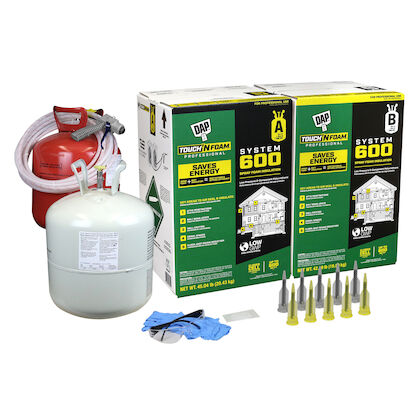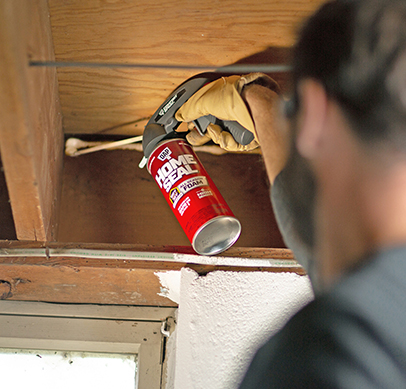
How to Insulate Rim Joists
Want to make your home more energy efficient? Try one of the most effective methods: insulating with spray foam.

-
How to Insulate Rim Joists Step-By-Step
How to Insulate Rim Joists Step-By-Step
Tools
- Shop vac
- Fan
- Plastic drop cloths
- Gloves
- NIOSH-approved half- or full-face air-purifier respirator mask (recommended)
- Tyvek suit (recommended)
- Safety goggles
- Lined garbage can
Rim joists have the important job of supporting the structural elements of your home’s floor. Because the joists can be a source of major heat loss, one must-do for energy conservation is sealing and insulating them. You’ve got a couple of options. One requires several products, such as expanding foam sealant, rigid foam insulation and caulk. The other calls for just one product—a two-component spray foam sealant that fills gaps around pipes and seals and insulates joists.
If you’re going the simplified route, the foam sealant to try is DAP Touch ‘n Foam Pro System 15, 200 or 600. These self-contained, portable and disposable polyurethane spray foam systems consist of the chemicals in two canisters, along with hoses and nozzles. The Pro System 15 covers 15 board feet (a board foot is 1 foot x 1 foot x 1-inch thick), the 200 covers 200 board feet and the 600 covers 600 board feet. All options dry to the touch in 60 seconds, provide an R-value of 6.2 per inch and contain no ozone-depleting chemicals. You can use them for wall cavity insulation too.
It takes a little practice to get the hang of spray foam insulation. But once you do, you can move through a project fairly quickly.
Step 1: Check Temperatures
It’s critical to achieve proper temperatures for three things: the polyurethane foam tanks, the surface you’ll be insulating and the air. If you don’t have temperatures within certain ranges, the foam may not perform properly. The polyurethane should be between 70 and 90 degrees Fahrenheit; surfaces and air between 60 and 90 F.
Step 2: Clean Surfaces
Clean the area you’ll be insulating. The insulation won’t adhere if there’s loose dirt or even cobwebs on the surface. A shop vac makes quick work of the job. Make sure you get all the prep work done before you start spraying.

Step 3: Use Drop Cloths
Protect the floor near the area you’ll be spraying with plastic drop cloths. Any foam that lands on the plastic sheet can simply be picked off when it’s cured, unlike with cloth ones.

Step 4: Wear Protective Gear and Ventilate
You need to protect your skin from contact with the foam, so make sure to cover all exposed skin. Because the foam will ruin any fabric it touches, consider wearing a disposable Tyvek suit and gloves. The suit completely protects your skin and can be used multiple times. Additionally, provide good ventilation and wear eye protection and a mask. A NIOSH-approved half- or full-face air purifier respirator mask protects you fully from breathing in chemicals and is highly recommended in closed spaces with little circulation.

Step 5: Arrange Setup and Do a Test Spray
Always follow the manufacturer’s directions. When ready to begin your project, install hoses (if using the Touch ‘n Foam 200 or 600) and fully open valves on the tanks to charge the hoses with spray foam. Disengage the applicator safety switch and press the trigger fully to spray foam into a lined garbage can until each foam stream (yellow and white) flows evenly. Then attach a nozzle (use petroleum jelly if desired on attachment point) and do a test spray into the garbage can or onto scrap cardboard to become comfortable with the application process. Keep the nozzle moving as you spray and make sure the foam is dispensing properly. Foam will expand, be off-white in color and dry to the touch in 45 to 60 seconds.

Step 6: Picture-frame Cavity
Use the cone nozzle to spray about a 3-inch-wide x ½-inch-deep continuous wet bead of foam around the perimeter of each cavity. This provides an airtight seal. The wet chemicals normally expand two times their original volume. Work steadily, doing all picture-frame spraying at once. Try not to stop for more than a few seconds or the foam will start to cure in the nozzle and you’ll need to replace it with a new one (the Touch ‘n Foam kit has five cone and five fan nozzles).

Bonus Tip: You should also seal the gap between the sill plate and foundation. Use caulk for small gaps; for larger gaps, apply ½ inch of the spray foam sealant.
Step 7: Spray Rest of Cavity
Change to the fan nozzle and go back to where you started. Make sure the foam is cool to the touch (it should cool in a minute or two, depending on conditions). Then cover the remaining surface with ½ inch of foam (it expands approximately two times the wet thickness), moving steadily back and forth across the surface. Move quickly from one cavity to the next until you fill all of them. After the foam is cool to the touch, go back to where you started and fill in up to ½ inch additional foam, for a total cured depth of 2 inches. (Two inches maximum of cured foam meets Class A (I) fire rating requirements.)
Follow the manufacturer’s instructions for cleaning hoses and nozzles. Leftover product can be stored for up to 30 days. Trim off any excess insulation in the cavities with a utility knife.

NOTE: Refer to manufacturer’s instructions and videos for more detailed information on safety and proper use of Touch ‘n Foam 15, 200 and 600 Kits.
-
Recommended Products
Product Recommendations

DAP Touch 'n Foam Low GWP System 200 Foam Insulation Kit
A portable, disposable foam insulation kit with quick-drying properties and fire-rated features, perfect for enhancing R-value and air sealing.
View Product
Touch ‘n Foam® Professional Low GWP Foam Kit 15 1.75 PCF FR ICC
System 15 Low GWP provides a quick, consistent flow of foam with rapid curing to insulate stud wall cavities, gaps, cracks, expansion joints, and other sources of air leakage.
View Product
Touch ‘n Foam® Professional Low GWP Foam Kit 600 1.75 PCF FR
Touch ‘n Foam System 600 is a completely self-contained two-component foam system that is portable and disposable.
View Product -
Related Projects
Related Projects
![no warp foam]()
How to Seal and Insulate a Window and Door
Prevent air leaks and help your home be more energy efficient and comfortable with this step-by-step project.
Read More![home seal]()
How to Winterize Your Home
Ready for that cold snap? Here’s how to make your home more comfortable and energy efficient—and maybe even save you some money.
Read More![mouse shield]()
How to Pestproof Your Home
Take these steps to keep mice, spiders and insects out of your personal space.
Read More![dynaflex 230]()
How to Fix Drafty Windows
Keep currents of cool air in check with these indoor and outdoor solutions.
Read More

 USA - EN
USA - EN Canada - EN
Canada - EN


